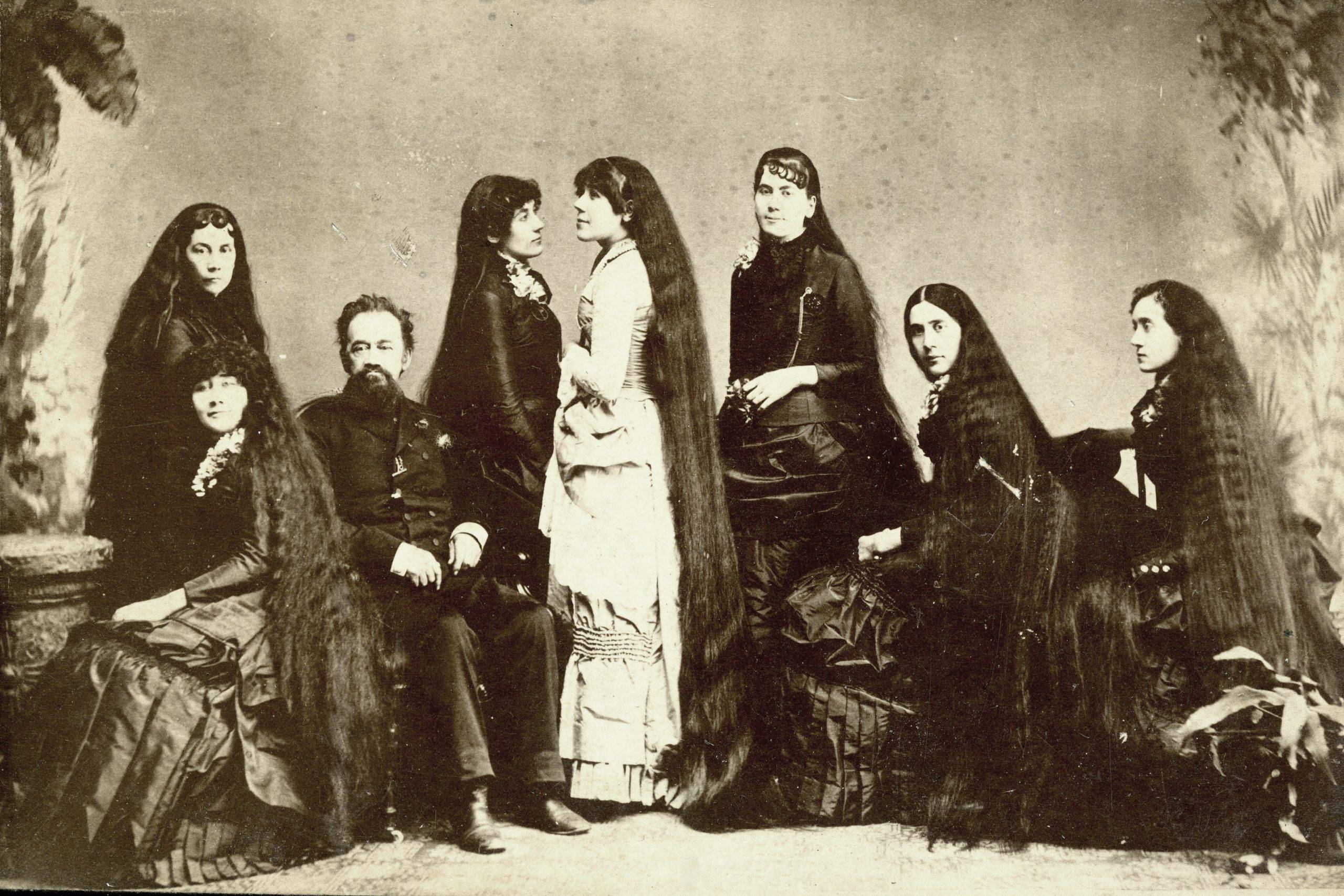

Editorials
The Seven Sutherland Sisters & The Downfall of a Generation
The Sutherland Sisters, better known as the seven headline-stealing wonders of the Victorian era, faded into obscurity after a life of greed, abuse, and fame.
There was a time when The Seven Sutherland Sisters were a trademark, thanks to their long hair and musical ability, but everything came crashing down as the turn of the century brought new styles and looks. This story symbolizes change and the dying of an age for the beginning of a new one. Read the story down below!
The Sutherland Family
In the first half of the 1800s in Cambria, New York, the seven Sutherland sisters were born within 14 years: Sarah, Victoria, Isabella, Grace, Naomi, Dora, and Mary.
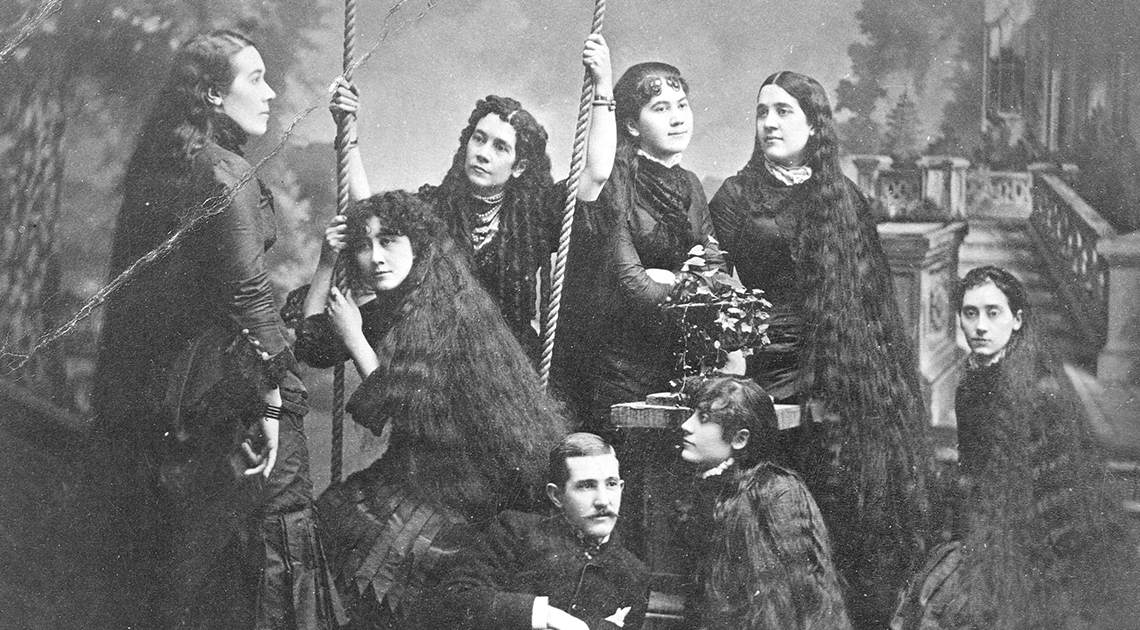
The Sutherland Sisters Family
They shepherded turkeys barefoot in shabby clothes, and to make matters worse, their mother, Mary, would slather their long hair with a horrible-smelling ointment she believed would make it grow thick and strong.
The farm had been established by their grandfather, Col. Andrew Sutherland, an inventor who was esteemed for his role in the 1812 War.
Meanwhile, their lazy father, Fletcher Sutherland, preoccupied himself with proselytizing and politicking. A preacher, politician, inventor, writer, and all-around smoothing-talking showman, Fletcher once worked for President James Buchanan, and nearly got himself murdered for opposing the Civil War. But Fletcher always had more hopes for his children than a life of tending turkeys. When they were little, he started showcasing his daughters’ singing abilities at church.
In 1867, Mary Sutherland, the girls’ mother, died, and after she passed her father, Fletcher, was more determined than ever to pursue his dreams of fame and fortune by exploiting his children.
The Sutherland children, including the girls’ only brother, Charles, started to pick up musical instruments and tour churches, fairs, and community theaters around Niagara County as the “Sutherland Concert of Seven Sisters, and one Brother”.
Billed as “The Seven Wonders,” the Sutherland sisters, now performing without Charles, made it to New York City in early December 1880, where their actions and impressive tresses made their Broadway debut.
In the summer of 1881, the Seven Sutherland Sisters took their show on the road, touring the South, before landing at the first World’s Fair in the South, the International Cotton Exposition, in Atlanta, Georgia, in the fall of 1881. Everywhere they went, audiences would audibly gasp when the young women unleashed their locks, shimmering under the gaslights.
Sarah, the oldest Sutherland sister, only had 3 feet of thick, wavy hair, the shortest hair of the group. But when the sisters posed for photo shoots, generally, Sarah would sit and others would bend their waists so that it seemed that all seven had hair that brushed the ground.
Mary, the youngest, was mentally unstable her whole life, and some doctors and preachers went as far as blaming her 6 feet of very heavy, dark hair for pulling on her head.
The Circus & The Baileys
Aside from their intoxicating hair that envious fans would sometimes try to cut and steal, their number, seven—considered a holy, biblical number—ascribed another level of mysticism to their act. Agents came knocking, as did the moguls of the vaudeville and circus circuit.
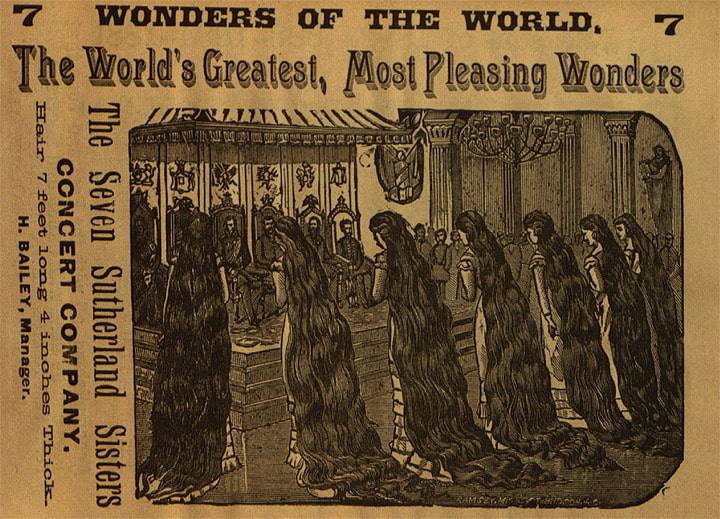
The Sutherland Sisters Pleasing Wonders
By 1882, the sisters signed a deal to tour with W.W. Coles Colossal Shows, and by 1884, the sisters had joined Barnum and Bailey’s Greatest Show on Earth as a sideshow attraction. P.T. Barnum himself dubbed them, “the seven most pleasing wonders of the world.”
Even though they were with Barnum and Bailey, the Seven Sutherland Sisters set themselves apart from circus folk and sideshow freaks, who were reviled by polite society. They were elevated by their goddess-like status and their refined, tasteful act, which involved engaging, articulate stories, church music, and drawing-room songs. Middle-class Americans considered their show dignified and enlightening.
The sisters were a runaway success. But the stage income must not have been enough for Fletcher, who started toying with the idea of a hair-growing tonic in 1882, based on the late mother Mary’s foul-smelling ointment.
He claimed that he created his concoction to reverse and prevent his balding process, but it was likely a sham and he just wanted to capitalize on his daughter’s stunning tresses. Fletcher’s presumably less-odious hair tonic didn’t catch on until he joined forces with Harry Bailey (born J. Henry), a relative of circus magnate James A. Bailey, who was also courting Naomi. Bailey founded the Sutherland Sisters Corporation and applied for the company’s first trademark in 1883, for the Seven Sutherland Sisters Hair Grower.
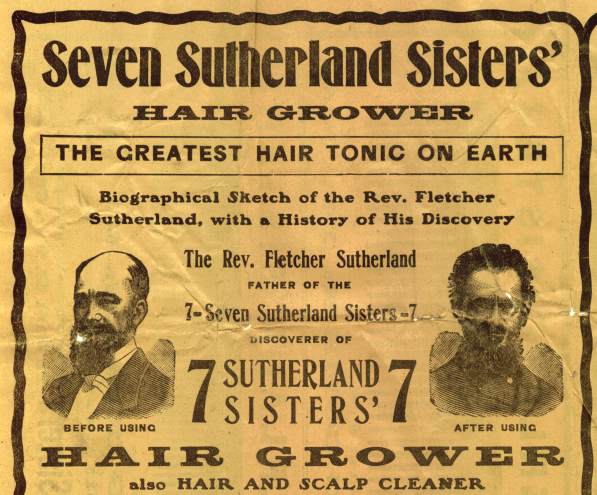
The Sutherland Sisters Hair Tonic Advertisement
By the end of 1884, the Sutherland Sisters Corporation had garnered $90,000 in sales. In 1885, Harry Bailey and Naomi Sutherland were married, and the couple had three children before Naomi’s death in 1893. Fletcher died around 1888, and the sisters themselves became part-owners in the company, which expanded to include a whole line of hair products including a comb, a scalp cleanser, and eight shades of “Colorators,” as well as other cosmetics like face cream.
Sutherland’s Mansion in Cambria
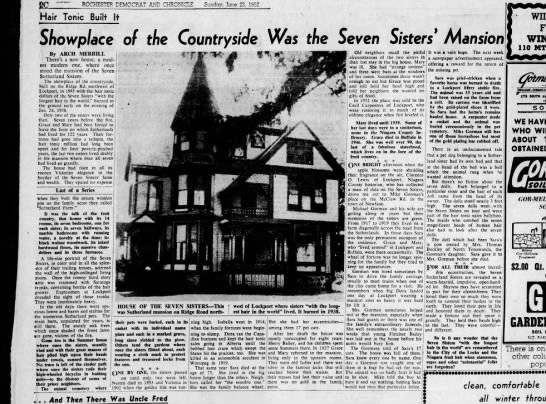
Sutherland Sisters Article
The fame and wealth gained in a short time, however, had a profound impact on the sisters, who as time went by became more and more eccentric.
In 1893 the seven sisters, now famous all over the world, returned home determined to live all together. Here stood a majestic villa where the old family farm once stood.
The 14-room dream home—which also became the headquarters of their business—looked something like a princess’s castle with a turret, cupola, and veranda. Inside, the family and their guests luxuriated with all-hardwood floors under their feet, heavy crystal chandeliers overhead, and black walnut woodwork all around them.
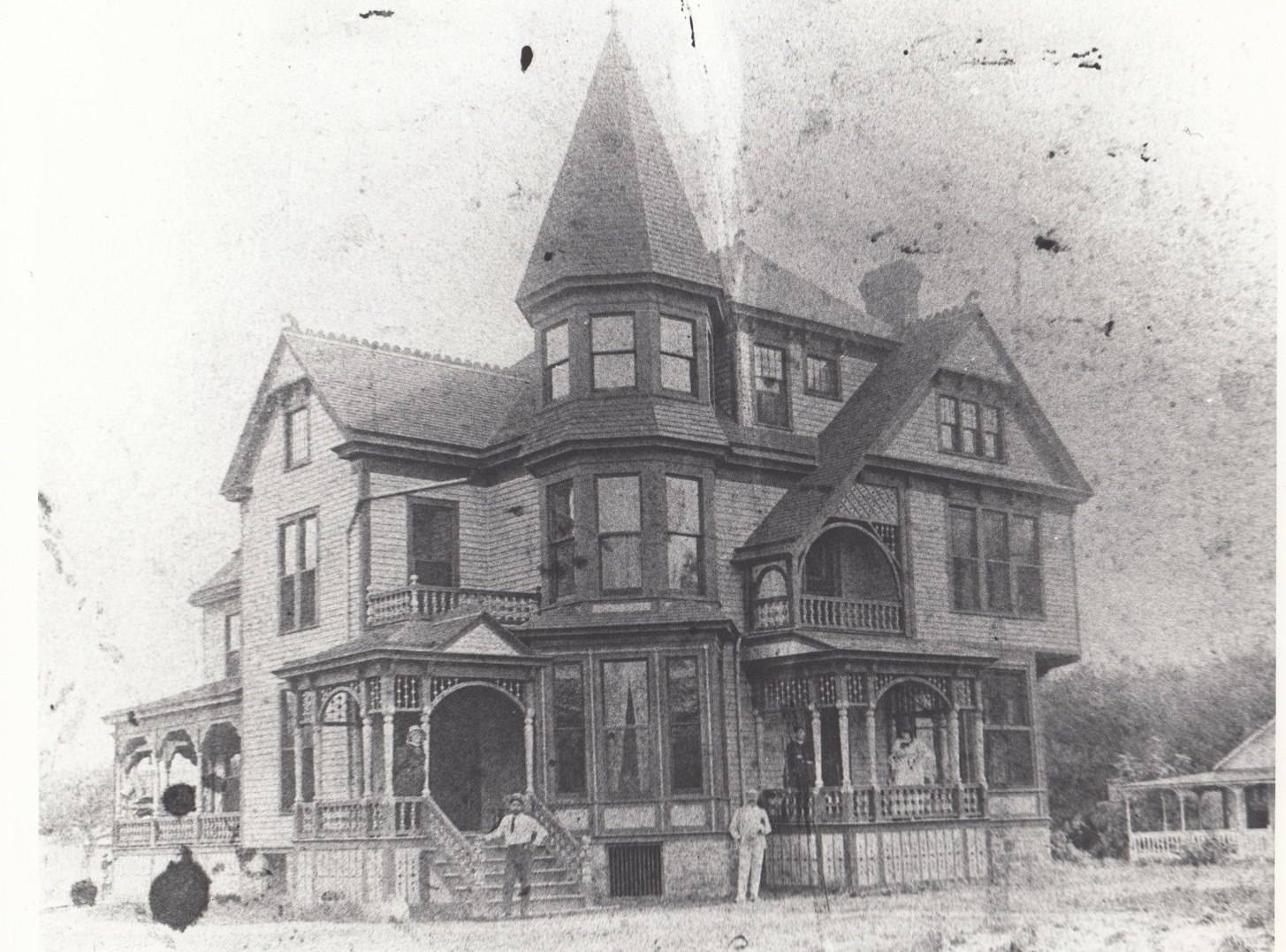
The Sutherland Sisters’ Mansion
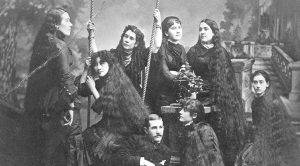
The Sutherland Sisters Family
The opulent estate featured the first indoor bathroom in Cambria, a marble beauty with hot and cold running water, as well as beds imported from Europe. Even the servants had posh, well-appointed rooms in the attic.
The Decline
Even though they were raking in millions at the turn of the century, the women’s spending on such extravagances—servants, clothes, fine jewelry, second homes, globe-trotting, booze, and lovers—was out of control. Outwardly, they maintained the appearances of proper, educated Christians, but behind closed doors, they engaged in love triangles, in-fighting, drug use, and bad financial investments. Their antics and wild, over-the-top parties were the talks of Niagara County, as people speculated about whether they were polyamorous or practicing spiritualism or witchcraft.
Naomi barely got to enjoy the spoils of their outlandish life in the mansion—she died before age 40 in 1893, the year the home was completed. Her death shook the sisters to the core. The family planned to invest $30,000 in a mausoleum, but it never came to be, reports Susan Tobias in her 2012 Plattsburgh, NY, Press-Republican article. As the sisters were still touring with Barnum’s and continued to do so until 1907, the group quickly auditioned for her replacement and chose Anna Louise Roberts, a woman from Carbondale, Pennsylvania, who had 9 feet of hair. Each subsequent death in the family made the sisters more and more heartbroken. They even invested $500 to have a full-on funeral with a casket, flowers, and crepe on the door when a beloved dog passed away.
A young French nobleman by the name of Frederick Castlemaine came around to court the lovely Dora but ended up marrying 40-something Isabella, who was more than 10 years his senior. In 1897, while accompanying the sisters on one of their tours, Castlemaine committed suicide.”
The sisters didn’t have Castlemaine embalmed right away. Instead, they put his body in a glass case, which they would visit and sing to daily. After 10 days the smell got so troubling, local health officials stepped in and forced the family to bury him in his mausoleum at Glenwood Cemetery in Lockport, NY, where most of the Sutherland sisters ended up after they died. Isabella couldn’t get over it for two years and talked to him at his grave every night until she met Alonzo Swain, the second much-younger man she married.
Victoria, ever the beauty, finally married a 19-year-old man when she was 50. This outraged her sisters, who kicked her out of the mansion and ostracized her for the rest of her short life; she passed away at 53 in 1902. A woman with 6 feet of hair, Anna Haney, was hired as her replacement. Meanwhile, mentally unwell Mary got increasingly antisocial, and when she threatened her family with spells, her sisters would lock her in her room. When the bandleader Sarah died in 1919, the family, once again, kept her body on display in the home and resisted burying her.
The Last Hollywood Trip
The final death knell to the Sutherlands’ prosperity came in the 1910s: Rebellious young women, known as flappers, started to chop their hair into startlingly short bobs. As the trend grew more mainstream, the appeal of the Seven Sutherland Sisters Hair Grower plunged. Isabella died in 1914, and the family fortune was slipping away fast. The last three women headed to Los Angeles in 1919 in a desperate attempt to pitch their story to Hollywood, but the deal went sour and Dora was killed in a car crash during their trip. Mary and Grace were so broke at that point, they didn’t even have the money to get her cremated, so they never claimed her remains.
The Last of The Sisters
By 1920, these two were the only living sisters, and they attempted to keep their “hair fertilizer” business alive in an era that no longer loved ridiculously long locks. Hardly able to buy food, they had to abandon their mansion in 1931. By 1936, the Seven Sutherland Sisters went out of business for good.
The empty estate caught on fire and burned to the ground on January 24, 1938, and endless numbers of Seven Sutherland Sisters documents—including, possibly, the patent tonic recipes—and artifacts went up in smoke. Mary ended up committed to Buffalo State Asylum for the Insane, where she died in 1939. Grace died destitute at age 92 in 1946, and as there was no room for her in the Castlemaine mausoleum, she was buried in an unmarked grave, and so the seven headline-stealing wonders of the Victorian era faded into obscurity.
If you liked this story, feel free to check out more stories here!













